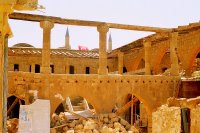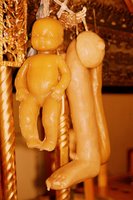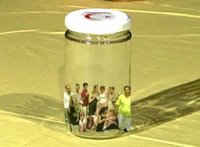The Cyprus Problem
| THE WARNING SIGNS were there from the start. When a Greek Orthodox bishop welcomed the first British governor to the island in 1878, the bishop told him that the Cypriots accepted the change of government because they believed that Britain would unite Cyprus with “Mother Greece.” The cry for énosis, |  |
| or the union of Cyprus with Greece, would grow more persistent over the years. But Turkish Cypriots, who | Greek and Turkish flags stake out both sides of Paphos Gate in Nicosia. ........................................ |
|---|
A series of explosions shook the island on April 1, 1955. The battle for énosis had begun. A year earlier, the Greek Cypriots had secretly formed EOKA, Ethnikí Orgánosis Kypríon Agonistón, or “National Organization of Cypriot Fighters.” They had the blessing of Archbishop Makarios III, who was both the spiritual and civil leader of the Greek Cypriots. But EOKA’s military chief was George Grivas, a native Cypriot who had risen through the officer’s ranks in the army of mainland Greece. His nom de guerre was “Dighenis,” an ominous name to anyone familiar with the Medieval Byzantine folk hero, wrote Lawrence Durrell, a British novelist and colonial flack, in his memoir Bitter Lemons of Cyprus.
Soon enough, the Turkish Cypriots formed TMT, Turk Mukavemet Teskilati, or Turkish Resistance Organization, which launched its first attack in 1958. TMT wanted taksim, the division of the island into Greek and Turkish zones. The first serious intercommunual violence ensued. Turkish and Greek Cypriots were expelled from mixed neighborhoods. Turkish Cypriot policemen working for the British were assassinated. And unarmed civilians were “shot down like rabbits in church, at the coffee-house, even in hospital,” Durrell wrote. The death toll mounted to around 600, many of them Greek Cypriots that EOKA deemed too pro-British.
By 1959 Britain, Greece and Turkey agreed in principle to grant Cyprus independence, but with a constitution that permanently forbid both énosis and taksim. They also agreed to let an impartial Swiss expert draft the constitution, which the Cypriots themselves had very little voice in creating. Many Greek Cypriots felt betrayed because Makarios had abandoned the dream of énosis for mere independence.
But as far as the Greek Cypriots were concerned, the worst was yet to come. They were most unhappy with the power-sharing agrangement in the constitution, which they felt favored the Turkish minority. There was a single fifty-seat House of Representatives, with 15 seats reserved for Turkish Cypriots. The president would always be a Greek Cypriot, with a Turkish Cypriot vice president, and both would have veto power. But the real seeds of future conflict were buried in three related treaties.Treaty of Establishment set aside 99 square miles, or about 3 percent of the island, for British military bases that are not part of the Republic of Cyprus. The Treaty of Alliance allowed the permanent stationing of Greek and Turkish military forces on the island. And in the Treaty of Guarantee, Britain, Greece and Turkey all agreed to safeguard the island’s independence, should anything alter the conditions of the constitution. In this way, after more than 2,000 years of foreign rule, Cyprus achieved independence—of a sort—on April 16th, 1960.
The honeymoon didn’t last long. The constitution created an unworkable government. For one thing, a majority of both groups was required to pass new legislation, which meant that eight of the 15 Turkish Cypriot representatives could torpedo any potential new law. In November 1963, Makarios, who had been overwhelmingly elected president, proposed 13 constitutional amendments. Each one would have reduced some Turkish Cypriot political advantage. He submitted them to the Turkish Cypriot vice president, who vetoed all 13—including the amendment that would have eliminated the presidential and vice presidential vetoes. It’s unclear what Makarios hoped to gain by this gambit, when he might have foreseen this veto. What he got was a bloody Christmas.
Tensions between Greek and Turkish Cypriots were running high, and EOKA and TMT members were still swaggering about. On December 21st, they took to the streets. Mainland Turkish and Greek troops stationed on the island left their barracks. Greek and Turkish Cypriots set up makeshift barricades in Nicosia, using tires and old mattresses—barriers that soon became known as the Green Line, after a green marking that a British officer drew on a map. Britain brokered a ceasefire on Christmas day, and U.N. peacekeepers arrived in February. But the killings continued.
By mid-1964, 10,000 mainland Greek troops had landed on Cyprus, and Turkish troops were massed along the Turkish mainland just across the water. Most of the Turkish Cypriots—who had lived for centuries scattered across the island, often in integrated villages—were now wholly segregated in heavily-armed enclaves. Dean Acheson, the U.S. secretary of state, unveiled a plan to partition the island between Greece and Turkey—a sort of double-énosis. The Cypriot experiment with soverignty would come to a swift end. The Acheson plan was soundly rejected.
The hot Cypriot summer wore on. Then in August, Grivas led Greek Cypriot National Guardsmen in an attack on TMT’s stronghold—the Kókkina enclave, on the island’s northwest coast near Polis—where they were landing Turkish arms. Turkey unleashed its warplanes, which bombed and straffed nearby Greek Cypriot villages with rockets and napalm. Makarios threatened reprisals on Turkish Cypriots throughout the island. The airstrikes ended after two days. But by the end of 1964, the Turkish Cypriots were all firmly barricaded in their enclaves. That made it easy for the central government, which was entirely Greek Cypriot by then, to ban a wide range of essential goods from reaching them. One Turkish Cypriot, who grew up in the enclaves, told me that he had never seen a banana until 1974.
For nearly a decade, Cyprus continued in a sort of suspended animation. In 1973, when the English travel writer Colin Thubron trekked around the island by foot for his book Journey into Cyprus, he observed a state of affairs not unlike the Middle Ages, when knights defended fortified villages on the Cypriot coastline. Thubron even explored ancient Roman passageways in copper mines where Cypriots still toiled, although by the 1970s they worked for an American mining company.
But the timeless world that Thubron described ended dramatically the following year. In the early hours of July 15th, 1974, Greek Cypriot National Guardsmen stormed the presidential palace. They were following the orders of mainland Greek officers. Greece itself had been a military dictatorship ever since a coup in 1967, and Greek Army officers had essentially commanded the Cypriot National Guard from its inception. The soldiers declared that Makarios was dead, and the new president was Nikos Sampson, a long-time EOKA fighter. But Makarios reemerged later that day—very much alive—in the Paphos district of Cyprus. The British troops stationed nearby airlifted him off the island.
Five days later, on July 20th, Turkish troops landed in Kyrenia, in the heart of north Cyprus. To this day, Turkey and many Turkish Cypriots refer to this as the 1974 peace operation. They also prefer the word “intervention” to the word “invasion,” because they say that Turkey was acting properly under the Treaty of Guarantee. But many Greek Cypriots say that Turkey used the Treaty of Guarantee as a pretext for invasion.
On July 23rd, the Greek junta in Athens and its puppet government in Nicosia collapsed. Civilian governments were restored in both capitals. The three guarantor powers—Britain, Greece and Turkey—negotiated a ceasefire on July 30th. But fruitless negotiations continued, while the troops on the ground laced the island with landmines. On August 14th, Turkey mounted a second assault. And by August 16th, Turkey occupied a little more than one-third of the island. The Turkish frontline was not too dissimilar from what Turkey and Turkish Cypriots had long proposed as a partition. From that day on, the Green Line would bisect the entire island; and the United Nations would be responsible for the buffer zone between the Turkish and Greek cease-fire lines.
| Learn More About Cyprus: Overview Until 1950 > > Since 1950 < < | In 1983, Rauf Denktash, the Turkish Cypriot leader, unilaterally declared a separate state in the north, calling it the Turkish Republic of North Cyprus (TRNC). Today, some 30,000 mainland Turkish troops occupy north Cyprus, and |
|---|
Despite some ugly events in 1996—which left two Greek Cypriots and two Turkish Cypriots dead—tensions eased somewhat early in this decade. Greek Cypriot negotiations to enter the European Union gave many Cypriots fresh hope for a final settlement. But in April 2004, three out of four Greek Cypriots voted down a United Nations-brokered peace plan, called the Annan Plan, which would have reunited the island. Two out of three Turkish Cypriots voted for the plan. Today, many Turkish Cypriots complain that a final peace plan should have been a precondition for Cyprus joining the European Union. Meanwhile, some Greek Cypriots describe the Annan Plan as a “trick,” saying they were rushed into voting for an inferior plan just one week before joining the European Union.
While I spent the summer of 2005 in Cyprus, it felt like a malaise had settled over the island. Many of the top diplomats were leaving, or their posts were already vacant. Kiernan Prendergast, the U.N. undersecretary general for political affairs, had just informed the Security Council that he thought the Greek and Turkish Cypriots were too far apart and the mistrust between them was too deep to resume negotions at that time. But subtle changes were afoot on the island—not in response to anything the politicians or diplomats were doing—but because ordinary Greek and Turkish Cypriots were finally able to meet. In 2003, it became easier for them to travel from one side of the island to the other. Although the peace process remains in limbo, these everyday interactions may be the Cypriots’ best hope for bridging their divide.
tCr












